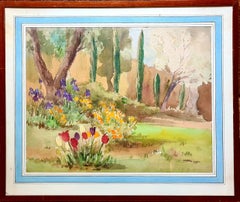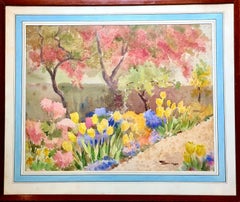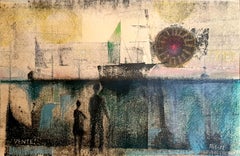La Galerie Cotignac Drawings and Watercolor Paintings
Late 20th Century Figurative Paintings
Gouache, Watercolor
Early 20th Century Impressionist Landscape Paintings
Watercolor, Gouache, Paper
Early 20th Century Impressionist Landscape Paintings
Paper, Watercolor, Gouache
Early 20th Century Impressionist Landscape Paintings
Paper, Watercolor, Gouache
Late 20th Century Surrealist Figurative Drawings and Watercolors
Paper, Oil Pastel
Late 20th Century Fauvist Figurative Drawings and Watercolors
Pastel, Paper
Late 20th Century Surrealist Still-life Paintings
Paper, Acrylic, Watercolor, Gouache
Early 20th Century Impressionist Still-life Drawings and Watercolors
Paper, Ink, Watercolor
Late 18th Century Rococo Portrait Drawings and Watercolors
Pastel, Paper
1970s Fauvist Landscape Paintings
Watercolor, Gouache
Mid-20th Century Post-Impressionist Landscape Drawings and Watercolors
Ink, Watercolor, Pencil
Mid-20th Century Constructivist Figurative Drawings and Watercolors
Paper, Watercolor, Ink, Pencil
Late 20th Century Realist Nude Drawings and Watercolors
Paper, Chalk, Crayon, Pastel
Late 20th Century Still-life Paintings
Silk, Watercolor, Handmade Paper, Gouache
Late 20th Century Still-life Paintings
Watercolor, Gouache, Handmade Paper, Silk
21st Century and Contemporary Surrealist Figurative Paintings
Gouache, Watercolor, Paper
Late 20th Century Surrealist Figurative Paintings
Gouache, Watercolor, Paper
Early 20th Century Art Deco Landscape Drawings and Watercolors
Paper, Watercolor
Early 20th Century Impressionist Landscape Drawings and Watercolors
Ink, Paper, Watercolor
Late 20th Century Renaissance Figurative Drawings and Watercolors
Crayon, Watercolor, Pencil
Late 20th Century Outsider Art Figurative Drawings and Watercolors
Chalk, Crayon, Pencil, Paper
Mid-20th Century Romantic Landscape Paintings
Watercolor, Paper
Late 20th Century Outsider Art Figurative Drawings and Watercolors
Chalk, Crayon, Cardboard, Pencil, Watercolor
Late 20th Century Impressionist Figurative Drawings and Watercolors
Paper, Watercolor
Early 20th Century Landscape Drawings and Watercolors
Watercolor, Paper
Late 19th Century Symbolist Figurative Drawings and Watercolors
Crayon, Pencil, Color Pencil
1960s Modern Landscape Paintings
Paper, Pastel, Ink, Watercolor
Early 20th Century Art Deco Landscape Drawings and Watercolors
Paper, Watercolor, Gouache, Pencil
Late 20th Century Expressionist Figurative Drawings and Watercolors
Paper, Watercolor, Gouache
Mid-20th Century Expressionist Still-life Drawings and Watercolors
Paper, Crayon, Pastel, Carbon Pencil
21st Century and Contemporary Impressionist Landscape Paintings
Paper, Pastel
Late 20th Century Modern Landscape Drawings and Watercolors
Paper, Watercolor
Early 20th Century Impressionist Portrait Drawings and Watercolors
Pencil, Handmade Paper
Early 20th Century Landscape Drawings and Watercolors
Paper, Crayon, Watercolor
Late 20th Century Impressionist Still-life Drawings and Watercolors
Paper, Watercolor, Gouache
Late 20th Century Expressionist Figurative Drawings and Watercolors
Crayon, Paper
Late 20th Century Expressionist Figurative Drawings and Watercolors
Crayon, Paper
Mid-20th Century Realist Animal Drawings and Watercolors
Gouache, Carbon Pencil, Handmade Paper, Watercolor, Silk
Mid-20th Century Realist Animal Drawings and Watercolors
Watercolor, Silk, Gouache, Handmade Paper, Carbon Pencil
Mid-20th Century Realist Animal Drawings and Watercolors
Silk, Watercolor, Gouache, Handmade Paper, Carbon Pencil
Mid-20th Century Realist Animal Drawings and Watercolors
Silk, Watercolor, Handmade Paper, Carbon Pencil, Gouache
Mid-20th Century Academic Animal Drawings and Watercolors
Watercolor, Gouache, Silk, Handmade Paper, Carbon Pencil
Early 20th Century French School Landscape Paintings
Paper, Oil, Watercolor, Board, Pencil
Early 20th Century Landscape Drawings and Watercolors
Paper, Watercolor, Pencil
Mid-20th Century Landscape Drawings and Watercolors
Watercolor, Paper
Mid-20th Century Art Deco Portrait Drawings and Watercolors
Paper, Crayon, Pastel
Late 20th Century Romantic Portrait Paintings
Paper, Watercolor, Gouache
1980s Abstract Expressionist Abstract Drawings and Watercolors
Paper, Carbon Pencil, Color Pencil
Late 20th Century Realist Figurative Drawings and Watercolors
Watercolor, Handmade Paper
1960s Landscape Drawings and Watercolors
Paper, Watercolor, Gouache
1970s Realist Landscape Drawings and Watercolors
Watercolor, Pencil, Gouache, Paper
Mid-20th Century Expressionist Figurative Drawings and Watercolors
Paper, Watercolor
Early 20th Century Animal Drawings and Watercolors
Watercolor, Paper, Gouache, Pencil
1970s Abstract Impressionist Figurative Drawings and Watercolors
Paper, Watercolor, Gouache, Handmade Paper
Late 20th Century Abstract Expressionist Abstract Drawings and Watercolors
Paper, Oil Pastel
1970s Outsider Art Figurative Drawings and Watercolors
Chalk, Cardboard
1970s Abstract Expressionist Animal Drawings and Watercolors
Paper, Chalk
Mid-20th Century Modern Nude Drawings and Watercolors
Paper, Charcoal, Crayon, Watercolor, Gouache
Mid-19th Century Landscape Drawings and Watercolors
Paper, Crayon, Pastel
Mid-19th Century Landscape Drawings and Watercolors
Paper, Crayon, Pastel





